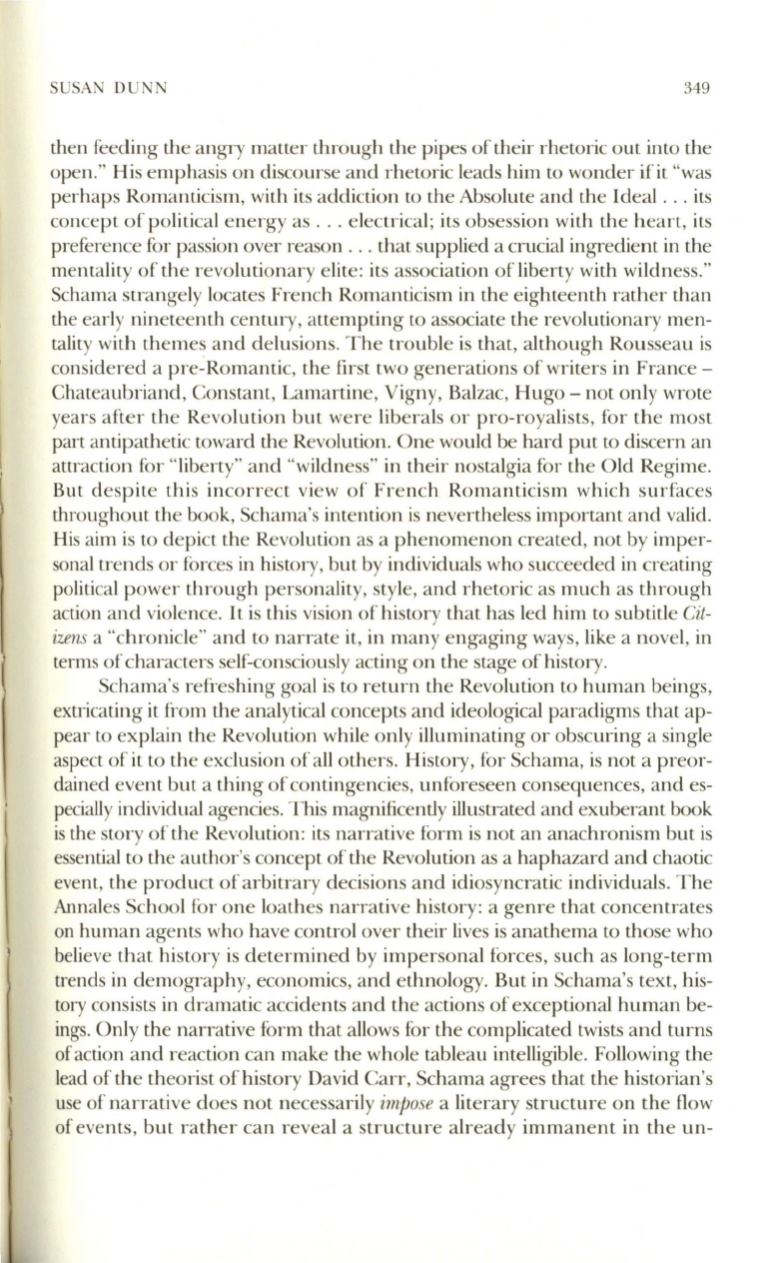
SUSA DUNN
349
then feeding the angry matter through the pipes of their rhetoric out into the
open." His emphasis on discourse and rhetoric leads him to wonder ifit "was
perhaps Romanticism, with its addiction to the Absolute and the Ideal ... its
concept of political energy as ... electrical; its obsession with the heart, its
preference for passion over reason ... that supplied a crucial ingredient in the
mentality of the revolutionary elite: its association ofliberty with wildness."
Schama strangely locates French Romanticism in the eighteenth rather than
the early nineteenth century, attempting to associate the revolutionary men–
tality with themes and delusions. The trouble is that, although Rousseau is
considered a pre-Romantic, the first two generations of writers in France -
Chateaubriand, Constant, Lamartine, Vigny, Balzac, Hugo - not only wrote
yea rs a fter the Revolution but were liberals or pro-royalists, for the most
part antipathetic toward the Revolution. One would be hard put
to
discern an
attraction for "libe rty" and "wildness" in their nostalgia for the Old Regime.
But despite this incorrect view of French Romanticism which surfaces
throughout the book, Schama's intention is nevertheless important and valid.
His aim is to depict the Revolution as a phenomenon created, not by imper–
sonal trends or forces in history, but by individuals who succeeded in creating
political power through personality, style, and rhetoric as much as through
action and violence. It is this vision of history that has led him to subtitle
Cit–
izens
a "chronicle" and
to
narrate it, in many engaging ways, like a novel, in
terms of characters self-consciously acting on the stage of history.
Schama's refi-eshing goal is to return the Revolution
to
human beings,
extricating it from the analytical concepts and ideological paradigms that ap–
pear to explain the Revolution while only illuminating or obscuring a single
aspect of it to the exclusion of all others. History, for Schama, is not a preor–
dained event but a thing of contingencies, unforeseen consequences, and es–
pecially individual agencies. This magnificently illustrated and exuberant book
is the story of the Revolution: its narrative form is not an anachronism but is
essential to the author's concept of the Revolution as a haphazard and chaotic
event, the product of arbitrary decisions and idiosyncratic individuals. The
Annales School for one loathes narrative history: a genre that concentrates
on human agents who have control over their lives is anathema to those who
believe that history is determined by impersonal forces , such as long-term
trends in demography, economics, and ethnology. But in Schama's text, his–
tory consists in dramatic accidents and the actions of exceptional human be–
ings. Only the narrative form that allows for the complicated twists and turns
of action and reaction can make the whole tableau intelligible. Following the
lead of the theorist of history David Carr, Schama agrees that the historian's
use of na rrative does not necessarily
impose
a literary structure on the flow
of events, but rather can reveal a structure already immanent in the un-


